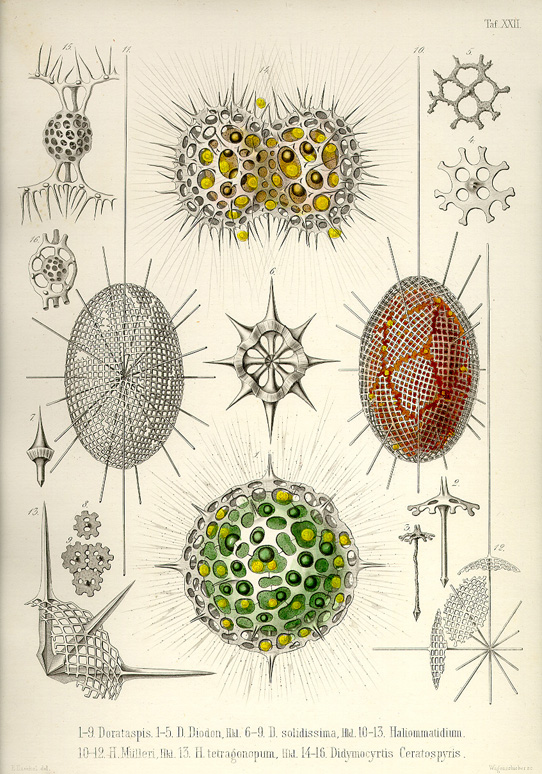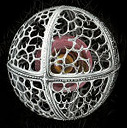Proteus: Film Screening and Q and A with Director David Lebrun

From Ernst Haeckel's Die Radiolarien, Berlin, 1862
Date: Friday, April 1
Time: 7:00 PM and 9:00 PM (2 Screenings)
Admission: $5
Presented by Morbid Anatomy in partnership with Proteus Gowanus
The ocean is a wilderness reaching ’round the globe, wilder than
a Bengal jungle, and fuller of monsters, washing the very wharves
of our cities and the gardens of our sea-side residences.
- Henry David Thoreau, 1864
For the nineteenth century, the world beneath the sea played much the same role that “outer space” played for the twentieth. The ocean depths were at once the ultimate scientific frontier and what Coleridge called “the reservoir of the soul”: the place of the unconscious, of imagination and the fantastic. Proteus uses the undersea world as the locus for a meditation on the troubled intersection of scientific and artistic vision. The one-hour film is based almost entirely on the images of nineteenth century painters, graphic artists, photographers and scientific illustrators, photographed from rare materials in European and American collections and brought to life through innovative animation.
The central figure of the film is biologist and artist Ernst Haeckel (1834-1919). As a young man, Haeckel found himself torn between seeming irreconcilables: science and art, materialism and religion, rationality and passion, outer and inner worlds. Through his discoveries beneath the sea, Haeckel would eventually reconcile these dualities, bringing science and art together in a unitary, almost mystical vision. His work would profoundly influence not only biology but also movements, thinkers and authors as disparate as Art Nouveau and Surrealism, Sigmund Freud and D.H. Lawrence, Vladimir Lenin and Thomas Edison.

Protista drawn by Ernst Haeckel
The key to Haeckel’s vision was a tiny undersea organism called the radiolarian. Haeckel discovered, described, classified and painted four thousand species of these one-celled creatures. They are among the earliest forms of life. In their intricate geometric skeletons, Haeckel saw all the future possibilities of organic and created form. Proteus explores their metamorphoses and celebrates their stunning beauty and seemingly infinite variety in animation sequences based on Haeckel’s graphic work.
Around Haeckel’s story, Proteus weaves a tapestry of poetry and myth, biology and oceanography, scientific history and spiritual biography. The legend of Faust and the alchemical journey of Coleridge’s Ancient Mariner are part of the story, together with the laying of the transatlantic telegraphic cable and the epic oceanographic voyage of HMS Challenger. All these threads lead us back to Haeckel and the radiolaria. Ultimately the film is a parable of both the difficulty and the possibility of unitary vision.
DAVID LEBRUN has served as producer, director, writer, cinematographer, animator and/or editor of more than sixty films, among them films on the Mazatec Indians of Oaxaca, a 1960s traveling commune, Tibetan mythology and a year in the life of a Maya village. He edited the Academy-award winning documentary Broken Rainbow, on the Hopi and Navajo of the American Southwest. Proteus premiered at Sundance and has won numerous international awards. The two-hour documentary feature Breaking the Maya Code (2008) tells the story of the 200-year quest to decipher the hieroglyphic script of the ancient Maya of central America; a drastically shortened version was broadcast on the PBS series NOVA and has been seen on television around the world. His experimental and animated works include the animated films Tanka (1976) and Metamorphosis (2010), works for multiple and variable-speed projectors such as Wind Over Water (1983), and a 2007 multimedia performance piece, Maya Variations, created in collaboration with composer Yuval Ron. Lebrun has taught film production and editing at the California Institute of the Arts and has curated numerous art exhibitions. He was president of First Light Video Publishing from 1987-1996, and since then president of Night Fire Films. He was a founding Board Member of the Center for Visual Music (CVM) and is on the Advisory Board of the Chabot Space & Science Center’s Maya Skies project. For a complete biography and filmography, please visit www.nightfirefilms.org.